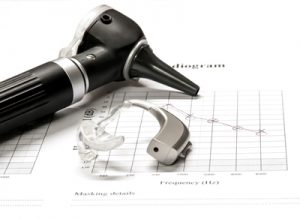What to Expect When You Need a Hearing Instrument
1. Session with the hearing care professional: diagnosis, choice of hearing instrument
 A hearing care professional or an ENT-physician determines with the help of a hearing test whether a hearing loss is present. If not, you won’t need any further help. In case a hearing loss is present, the kind and degree of your hearing loss is determined individually for each ear and entered in an audiogram. The hearing care professional presents you with the technological possibilities that would help in your case.
A hearing care professional or an ENT-physician determines with the help of a hearing test whether a hearing loss is present. If not, you won’t need any further help. In case a hearing loss is present, the kind and degree of your hearing loss is determined individually for each ear and entered in an audiogram. The hearing care professional presents you with the technological possibilities that would help in your case.
The hearing loss, the shape of your ear canals, your needs, taste, and budget are all taken into account to make the right decision concerning your hearing instruments and their technology, be it an in-the-ear or a behind-the-ear-model, digital, digitally programmable, analog, with or without a remote control or FM-receiver etc.
The hearing care professional may take an ear impression, an accurate replica of your ear canal, which is the basis for the ITE-shell (in case ITEs are used) or the BTE-earmold.
2. Session with the hearing care professional: fitting of hearing instrument
The hearing care professional has prepared your new hearing instruments. He/she will fit them into your ears and tune them to your specific hearing loss and your preferences. Additionally, he/she will inform you about the handling – how to insert and operate them and how to adjust the volume. You will also become familiar with their maintenance – how to change the batteries, clean and dry the instruments, etc… Finally, he/she might present you with some hearing examples and give you more details about the way your hearing instruments react in different situations. Now, you can return home with your new devices.
First steps with your new instrument:
In the next few days, you will become familiar with your new hearing instruments as you wear them for a few hours each day. Probably the easiest way to get to know and appreciate your new hearing instruments is to wear them in familiar surroundings. Get to know their characteristics when you speak to somebody and while you watch television etc. Your own voice might sound strange to you, possibly louder. If the loudness of other voices is appropriate, you might simply have learned to speak up in order to be able to
hear your own voice at all. Practice speaking with a softer voice.
Once you have become accustomed to the hearing instruments you will have an idea as to what could still be improved. You might want to have certain settings changed. Make a note of the situations which you think could be improved and visit your hearing care professional who will fine-tune your hearing instruments accordingly.
3. Session with the hearing care professional: Fine-tuning
Your hearing care professional will fine-tune your instruments according to your experiences. He/she will also answer some of your questions and give you general advice. Your hearing instrument now should have reached the stage where it is comfortably worn and offers the best possible intelligibility.
Whenever you have questions do not hesitate to contact your hearing care professional who will be happy to assist you.
Long-term use
Continue to use your hearing instruments on a daily basis for several hours. In this way, you will learn to use them best and benefit from them the most. Your hearing will be “trained” by the newly audible sounds and remains active, preventing a deterioration of the links between inner ear and brain. You will also find out whether you would benefit from any complementary devices such as an FM system which would give you additional support in difficult situations with noise, reverberation or distance or make watching television and making phone-calls easier.
Contact Us:
Our Offices:
Manahawkin, NJ
Phone: 609-978-9192
Toms River, NJ
Phone: 732-451-1950
Voorhees, NJ
Coastal Audiology
Phone: 856-795-5502
Precision Hearing Instruments
Phone: 856-428-0885
Manasquan, NJ
Phone: 732-451-1950
